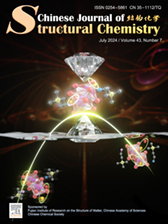
Pressure-induced emission in 0D metal halide (EATMP)SbBr5 by regulating exciton-phonon coupling
Jiayuan Liang, Xin Mi, Songhao Guo, Hui Luo, Kejun Bu, Tonghuan Fu, Menglin Duan, Yang Wang, Qingyang Hu, Rengen Xiong, Peng Qin*, Fuqiang Huang, Xujie Lü*
Submit a Manuscript
Si-Hua Liu, Jun-Hao Zhou, Jian-Ke Sun*
Chin. J. Struct. Chem., 2024, 43: 100312. DOI: 10.1016/j.cjsc.2024.100312
July 15, 2024
ABSTRACT
Recently, we have introduced a sharp oil/water-free interface to suppress the intrinsic van der Waals packing and direct the 2D self-assembly of POCs. The pre-organized cage layers were then in-situ crosslinked into continuous ultrathin cage nanofilms less than 8 nm in thickness. These networked cage nanofilms exhibit outstanding intrinsic water permeability at the 10 -5 cm2 s -1 scale, which is 1–2 orders of magnitude higher than that of traditional polymeric membranes, and comparable to that of other nanofluidic membranes such as MOFs, COFs and GO membranes. Molecular dynamics simulations revealed 1D water chains within the networked cage, mirroring features found in biological water channels. Moreover, the channel microenvironments, including hydrophilicity and steric hindrance, can be manipulated by a simple anion exchange strategy. The resulting “smart” membrane can even perform graded molecular sieving by ionically associating light-responsive anions to cage windows. As a proof-of-concept, continuous separation of three organic dyes in a single-stage, single-membrane process was exemplified. This achievement holds great promise for advancing the development of bio-inspired ultrathin nanofilms, particularly in the realms of smart separation technologies and nanofluidic devices.






